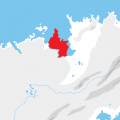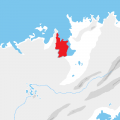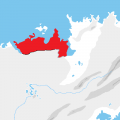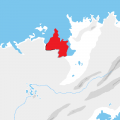Difference between revisions of "Archive:Q'eb Empire"
m (Ava moved page Q'eb Empire to Archive:Q'eb Empire) |
|
(No difference)
| |
Latest revision as of 23:37, 29 May 2020
 | This article or section is out of date. A country/countries relevant to this article have been removed from Sahar and have been retconned. Not everything here may still be considered canonical. This page was last edited by Ava (talk | contribs) 3 years ago. (Update) |
| Q'eb empire |
||||
|---|---|---|---|---|
|
||||
| Capital | Q'eb Mvadek | |||
| Government | Monarchy | |||
| b. | ... | |||
The Q'eb Empire was an empire of the Q'eb people living in North Baredina, it existed from about 200 BC to 1832 AD.
The Q'eb Empire existed continuously for more than 2,000 years before it was eventually annexed by the Meritocratic Republic of Myak Kham.
History
Before the Q'eb empire was established, there were several kingdoms built by the Q'eb people in the territory of the Q'eb empire.
In 202 BCE, Q'ebmad I of the Q'eb kingdom unified all kingdoms of the Q'eb people, building an empire called the Q'eb and became the first emperor of the empire. Soon after the establishment of the Q'eb empire, the Adzamasi Empire tried to invade the new-born Q'eb empire, but after several battles, the Adzamasi Empire failed, and the independence of the Q'eb empire was guaranteed.
During 202 BCE and 1205 CE, there were several dynasties, but the territory of the Q'eb empire changed a little during that time.
In 1205 CE, however, due to the expansion of the Grand Ekuostian Empire, the Q'eb empire lost the western part of its territory to the Grand Ekuostian Empire, the Q'eb people were converted into Iovism, and the Q'eb empire also became a tributary state of the Grand Ekuostian Empire until 1470, despite being nominally independent. During 1205-1470 CE when the time when the Q'eb empire was a tributary state of the Grand Ekuostian Empire, the Q'eb empire was required to pay tributes to the Grand Ekuostian Empire each year.
In 1470 CE, Kam T'achek XII, the emperor of the Q'eb empire of that time, decided to end its tributary relationship with the Grand Ekuostian Empire, however, the termination of the tributary relationship between the Q'eb empire and the Grand Ekuostian Empire enraged Mástát, the emperor of the Grand Ekuostian Empire at that time, so the Grand Ekuostian Empire invaded the Q'eb Empire as a retribution, but the invasion was failed.
In 1478 CE, the Q'eb empire allied with the Ebo Aga Empire, then the alliance of the Q'eb empire and the Ebo Aga Empire started to invade the northern area of the Grand Ekuostian Empire, the Q'eb empire took back all lost territories and expanded; however, the border of the Q'eb empire and the Ebo Aga Empire was never make sure, both countries tried to gain more territory, which caused several conflicts between the Q'eb empire and the Ebo Aga Empire, and the alliance of the Q'eb empire and the Ebo Aga Empire also ended.
In 1501 CE, the Q'eb empire and the Ebo Aga Empire finally settled down the controversy, they signed a treaty which delimited the boundary between the Q'eb empire and the Ebo Aga Empire, howver, the new boundary between both countries caused the Q'eb empire being completely surrounded by the Ebo Aga Empire, so the Q'eb empire started to seek an overseas territory, and they eventually aimed at Shekku, starting to fight against the Epyx empire and colonize Shekku.
In 1505, after four years of attempts, the Q'eb empire finally built up some colonies in Shekku, which formed collectively the Shekku settlement of the Q'eb Empire; and the original land of the Q'eb empire in Northern Baredina became Q'eb proper.
The regime of the Q'eb Empire in its colonies were highly oppressive, many indigenous Ya Amo people, especially males, were caught as slave and sent to Q'eb proper in north Baredina, which caused a strong dissatisfaction, in 1701, the Great Ya Amo Uprising broke out in parts of the Shekku settlement, as a result of the uprising, the kingdom of Kema Mi Amo was formed in 1707, and the Q'eb Empire lost parts of the Shekku settlement.
In the meanwhile, Hux Kham settlers living in the Ebo Aga Empire formed a new country called the Meritocratic Republic of Myak Kham in the west of the Q'eb Empire in 1603 CE, originally, the government of the Q'eb Empire downlooked the new country, but soon the Meritocratic Republic of Myak Kham became a local great power, becoming a powerful rival to the Q'eb Empire; also, being inspired by the Great Ya Amo Uprising, slaves riots in Q'eb proper increased since the 18th century; even worse, the Epyx empire tried to take back all its territories in mainland Shekku, all of which created burdens to the Q'eb Empire, weakening the power of the Q'eb Empire.
In response to the uprising slaves and the threat of the Meritocratic Republic of Myak Kham in the west, the Q'eb Empire needed a large amount of money to support the army and needed to concentrate most of its army in Q'eb proper, so in 1803 CE, the Q'eb Empire sold the north part of the Shekku settlement to Kema Mi Amo, to get the money the Q'eb empire needed. In 1822 CE, the Epyx empire suddenly invaded the rest parts of the Shekku settlement, making the Q'eb empire lose all its overseas territories. In 1832, the Q'eb empire was eventually conquered by the Meritocratic Republic of Myak Kham, the history for the Q'eb empire to be an independent country ended.
Historical territory of the Q'eb Empire
Historical territory of the Shekku settlement of the Q'eb Empire
- The Shekku settlement of the Q'eb Empire from 1505 AD from 1701 AD.png
The Shekku settlement of the Q'eb Empire from 1505 AD to 1707 AD
- The Shekku settlement of the Q'eb Empire from 1701 AD to 1803 AD.png
The Shekku settlement of the Q'eb Empire from 1707 AD to 1803 AD
- The Shekku settlement of the Q'eb Empire from 1803 AD to 1822 AD.png
The Shekku settlement of the Q'eb Empire from 1803 AD to 1822 AD
Culture
Language
The Q'eb empire uses the Q'eb language as its primary language, although Adzamic, the ancestor of Adzamic languages, was also common before 500 AD, and the Ebo Nganagam language have become a common colloquial language since about 1400 AD, as many ethnic Ebo Nganagam people started to settle themselves in the territory of the Q'eb empire since 1300s.
Social Class
The Q'eb Empire was a country with pervasive slavery and a social caste system, the status of everyone is decided when he or she is born, and the marriage between people from different classes is strictly banned, those who perform inter-class marriage would face the death penalty, and children of them became slaves.
There were several social classes in the social caste system of the Q'eb Empire:
- Priests, the caste for priests, teachers, scholars, and other religious("divine") figures.
- Aristocrats, the caste for governors, warriors and other secular people who take part in politics.
- Commoners, the caste for farmers, fishers, workers, artisans, businesspeople, and other people who work for a living.
- Slaves, the lowest caste, the unfree people.
Priests, aristocrats and commoners are free people, they are allowed to have their own properties; slaves are not allow to have their own properties, and slaves are properties of people from other castes.
Only priests and aristocrats have the right to take part in politics; and only priests have the right to teach knowledge; the emperor of the Q'eb Empire is seen as the head of both priests and aristocrats and the ultimate owner of all lands in the Q'eb Empire.





